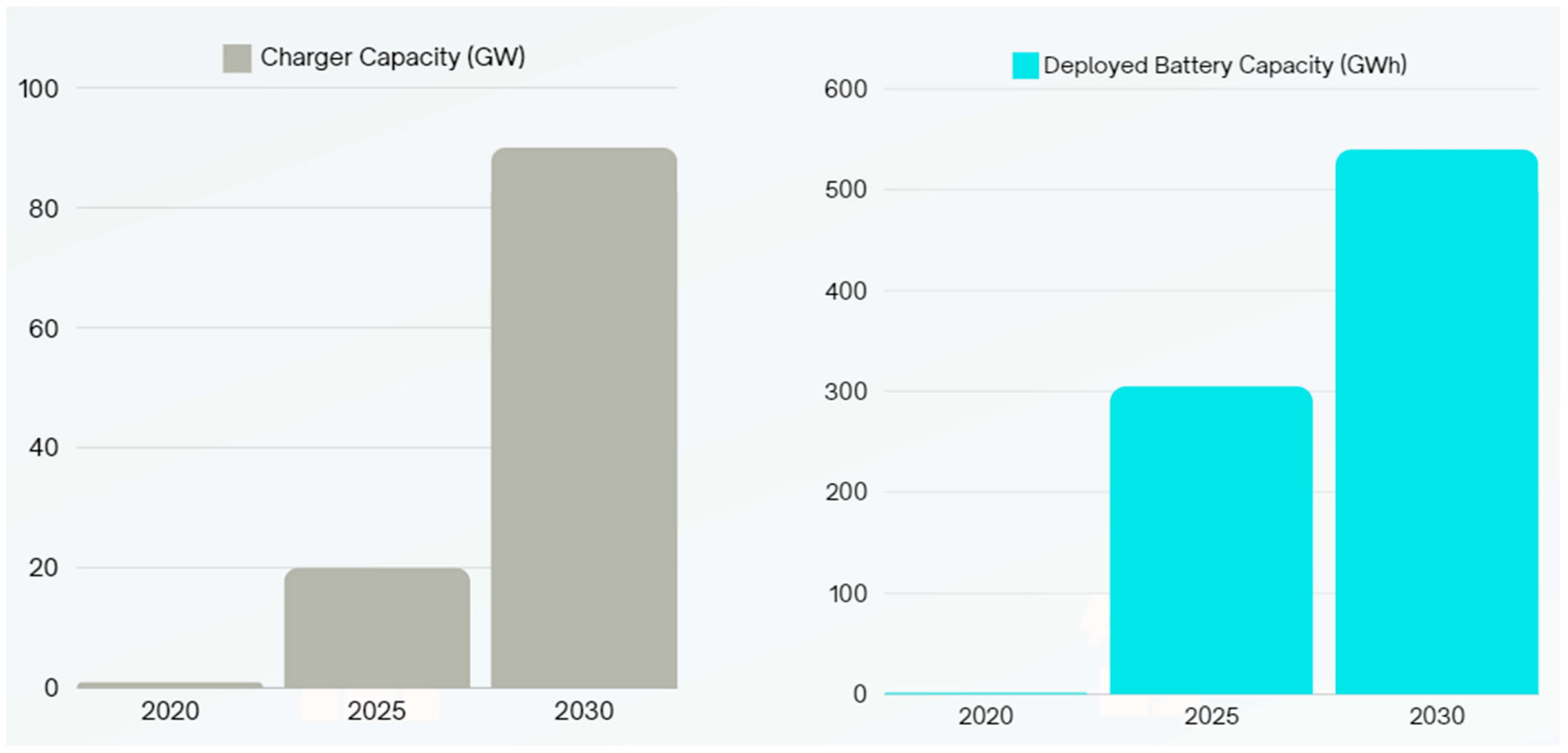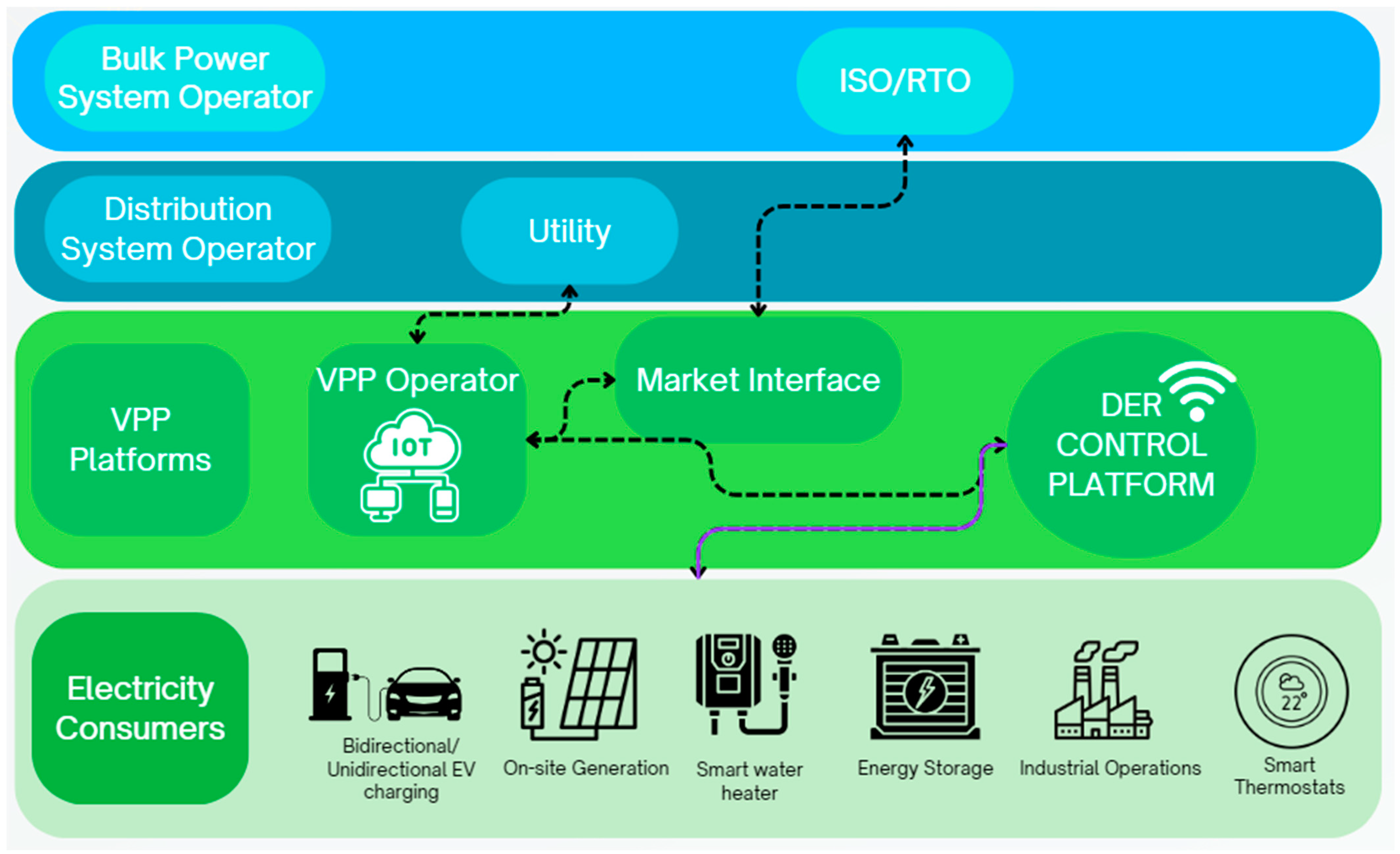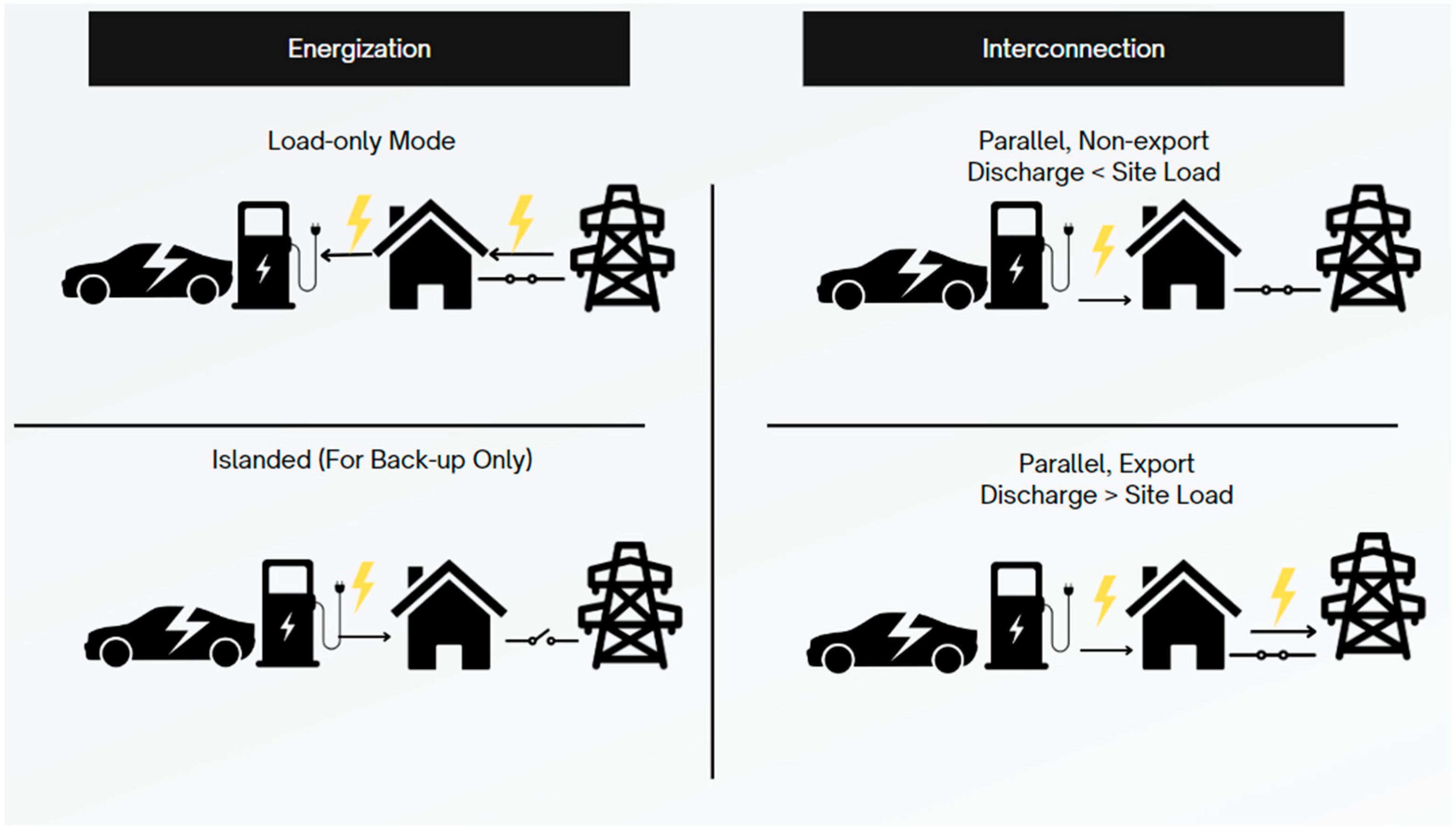A Review of Bidirectional Charging Grid Support Applications and Battery Degradation Considerations
Abstract
:1. Introduction
2. EV Batteries, EV Chargers, and Grid Demand
Virtual Power Plants and EV Charging Cost Reduction
3. Bidirectional Charging: Capabilities and Applications
3.1. Non-Exporting Bidirectional Charging
3.2. Exporting Bidirectional Charging
3.3. V2X Applications
3.3.1. Vehicle-to-Grid (V2G)
3.3.2. Vehicle-to-Microgrid (V2M)
3.3.3. Vehicle-to-Home/Building (V2H/V2B)
3.3.4. Other V2X Applications
3.4. Summary of V2G Adoption Challenges
4. V2X Case Studies Survey
5. Impact of Bi-Directional Charging Patterns on Battery Aging
5.1. Battery Aging Mechanisms
5.2. Aging-Aware Optimization of Bidirectional EV Charging
6. Continuing and Future Research
7. Conclusions
Funding
Conflicts of Interest
References
- Hledik, R. Real Reliability: The Value of Virtual Power: The Brattle Group; Peters, K., Ed.; Brattle Group: Boston, MA, USA, 2023. [Google Scholar]
- Denholm, P. Examining Supply-Side Options to Achieve 100% Clean Electricity by 2035; Patrick Brown, W.C., Ed.; NREL: Golden, CO, USA, 2022.
- Marinescu, B.; Bellmunt, O.; Dörfler, F.; Schulte, H.; Sigrist, L. Dynamic Virtual Power Plant: A New Concept for Grid Integration of Renewable Energy Sources. IEEE Access 2022, 10, 104980–104995. [Google Scholar] [CrossRef]
- Koraki, D.; Strunz, K. Wind and Solar Power Integration in Electricity Markets and Distribution Networks Through Service-Centric Virtual Power Plants. In Proceedings of the IEEE Power & Energy Society General Meeting (PESGM), Portland, OR, USA, 5–10 August 2018. [Google Scholar]
- Zhang, T.; Zhang, T.; Li, Y.; Yan, R.; Abu-Siada, A.; Guo, Y.; Liu, J.; Huo, R. A Master-Slave Game Optimization Model for Electric Power Companies Considering Virtual Power Plant. IEEE Access 2022, 10, 21812–21820. [Google Scholar] [CrossRef]
- Saboori, H.; Mohammadi, M.; Taghe, R. Virtual Power Plant (VPP), Definition, Concept, Components and Types. In Proceedings of the Asia-Pacific Power and Energy Engineering Conference, Chengdu, China, 28–31 March 2010; pp. 1–4. [Google Scholar] [CrossRef]
- Downing, J. Pathways to Commercial Liftoff: Virtual Power Plants; Johnson, M.M.N., Nemtzow, D., Oueid, R., Paladino, J., Wolfe, E.B., Eds.; Loan Programs Office, Department of Energy: Washington, DC, USA, 2023.
- NREL. The 2030 National Charging Network: Estimating U.S. Light-Duty Demand for Electric Vehicle Charging Infrastructure; National Renewable Energy Labs: Golden, CO, USA, 2023.
- Alternative Fuels Data Center. Developing Infrastructure to Charge Electric Vehicles; U.S. Department of Energy: Washington, DC, USA. Available online: https://afdc.energy.gov/fuels/electricity_stations.html. (accessed on 4 February 2024).
- Final Report of the California Joint Agencies Vehicle-Grid Integration Working Group. 2020. Available online: https://gridworks.org/wp-content/uploads/2020/07/VGI-Working-Group-Final-Report-6.30.20.pdf. (accessed on 4 February 2024).
- Demirci, A.; Tercan, S.M.; Cali, U.; Nakir, I. A Comprehensive Data Analysis of Electric Vehicle User Behaviors Toward Unlocking Vehicle-to-Grid Potential. IEEE Access 2023, 11, 9149–9165. [Google Scholar] [CrossRef]
- El-Hendawi, M.; Wang, Z. Multi-agent Optimization for Frequency Regulation through Vehicle-to-Grid Applications. In Proceedings of the IEEE 92nd Vehicular Technology Conference (VTC2020-Fall), Victoria, BC, Canada, 16 December 2020; pp. 1–5. [Google Scholar]
- Li, T.; Tao, T.S.; He, K.; Liu, J.; Yang, B.; Sun, Y. Behaviorally Realistic Model for Analyzing the Effect of V2G Participation. In Proceedings of the 4th International Conference on Energy, Electrical and Power Engineering (CEEPE), Chongqing, China, 23–25 April 2021; pp. 1229–1235. [Google Scholar]
- Bibak, B.; Tekiner-Mogulkoc, H. Influences of vehicle to grid (V2G) on power grid: An analysis by considering associated stochastic parameters explicitly. Sustain. Energy Grids Netw. 2021, 26, 100429. [Google Scholar] [CrossRef]
- Triviño, A.; Aguado, J.; de la Torre, S. Joint routing and scheduling for electric vehicles in smart grids with V2G. Energy 2019, 175, 113–122. [Google Scholar] [CrossRef]
- Zheng, Y.; Niu, S.; Yitong, S.; Shao, Z.; Jian, L. Integrating plug-in electric vehicles into power grids: A comprehensive review on power interaction mode, scheduling methodology and mathematical foundation. Renew. Sustain. Energy Rev. 2019, 112, 424–439. [Google Scholar] [CrossRef]
- Krueger, H.; Cruden, A. Integration of electric vehicle user charging preferences into Vehicle-to-Grid aggregator controls. Energy Rep. 2020, 6, 86–95. [Google Scholar] [CrossRef]
- Chai, Y.-T.; Tan, W.-N.; Gan, M.-T.; Yip, S.C. An Optimal Charging and Discharging Schedule to Maximize Revenue for Electrical Vehicle. In Proceedings of the 2019 IEEE Conference on Sustainable Utilization and Development in Engineering and Technologies (CSUDET), George Town, Malaysia, 7–9 November 2019; pp. 240–245. [Google Scholar]
- Amamra, S.-A.; Marco, J. Vehicle-to-Grid Aggregator to Support Power Grid and Reduce Electric Vehicle Charging Cost. IEEE Access 2019, 7, 178528–178538. [Google Scholar] [CrossRef]
- Fu, Y.; Walz, K.; Rudion, K. Analysis of Driving Patterns in Car Traffic and their Potential for Vehicle-to-Grid Applications. In Proceedings of the IEEE Madrid PowerTech, Madrid, Spain, 28 June–2 July 2021. [Google Scholar]
- Vehicle Technologies Office U.S. Department of Energy. Incremental Purchase Cost Methodology and Results for Clean Vehicles; Vehicle Technologies Office U.S. Department of Energy: Washington, DC, USA, 2022.
- North America Virtual Power Plant (VPP) Market; Wood McKenzie: Edinburgh, UK, 2019.
- Lin, K.N.; Leibowicz, B.; Niyongi, D.; Rai, V.; Santoso, S.; Spence, D.; Tompaldi, S.; Zhu, H.; Funkhouser, E.; Austgen, B. The Timeline and Events of the February 2021 Texas Electric Grid Blackouts; University of Texas at Austin: Austin, TX, USA, 2021. [Google Scholar]
- U.S Department of Energy. Heat Pump Water Heaters Achieve Significant Peak Reduction and Energy Savings; U.S Department of Energy: Washington, DC, USA, 2019.
- Octopus Energy. EV Energy Plan; Octopus Energy: London, UK, 2023. [Google Scholar]
- Fermata Energy. Firstlight Power; Fermata Energy: Charlottesville, VA, USA, 2022. [Google Scholar]
- Duke Energy. Illuminating Possibility: Duke Energy and Ford Motor Company Plan to Use F-150 Lightning Electric Trucks to Help Power the Grid; Duke Energy: Charlotte, NC, USA, 2022. [Google Scholar]
- Heydari, H.; O’Donnell, T. Supplementary Material for the Article: A Wide Range High Voltage Gain Bidirectional DC-DC Converter for V2G and G2V Hybrid EV Charger. IEEE Trans. Ind. Electron. 2021, 69, 4718–4729. [Google Scholar] [CrossRef]
- Khan, M.Y.A.; Saeed, L.; Saleem, J.; Arif, M.; Majid, A. A High Gain Multi-Port Bidirectional Non-Isolated DC-DC Converter for Renewable Integration. In Proceedings of the 2018 International Conference on Computing, Mathematics and Engineering Technologies (iCoMET), Sukkur, Pakistan, 3–4 March 2018; pp. 1–6. [Google Scholar]
- Chang, Y.-N.; Yan, Y.-H.; Huang, S.-M. An Isolated Three-Port Power Converter with 2C3L and 2C2L Resonant Circuits. Energies 2023, 16, 1830. [Google Scholar] [CrossRef]
- Tang, C.-Y.; Chen, P.-T.; Jheng, J.-H. Bidirectional Power Flow Control and Hybrid Charging Strategies for Three-Phase PV Power and Energy Storage Systems. IEEE Trans. Power Electron. 2021, 36, 12710–12720. [Google Scholar] [CrossRef]
- Blair, D.M.B.; Fitzgerald, G. The State of Bidirectional Charging in 2023; Smart Eletric Power Alliance: Washington, DC, USA, 2023. [Google Scholar]
- Ota, Y.; Taniguchi, H.; Nakajima, T.; Liyanage, K.M.; Baba, J.; Yokoyama, A. Autonomous Distributed V2G (Vehicle-to-Grid) Satisfying Scheduled Charging. IEEE Trans. Smart Grid 2012, 3, 559–564. [Google Scholar] [CrossRef]
- Gowda, S.; Zhang, T.; Kim, C.; Gadh, R.; Nazaripouya, H. Transmission, Distribution Deferral and Congestion Relief Services by Electric Vehicles. In Proceedings of the IEEE Power & Energy Society Innovative Smart Grid Technologies Conference (ISGT), Washington, DC, USA, 18–21 February 2019; pp. 1–5. [Google Scholar]
- Kaur, S.; Gupta, S. Analysis of Microgrid with Renewable Energy Sources and Energy Storage in Integrated Environment. In Proceedings of the IEEE North Karnataka Subsection Flagship International Conference (NKCon), Vijayapura, India, 20–21 November 2022; pp. 1–5. [Google Scholar] [CrossRef]
- Kaur, K.; Singh, M.; Kumar, N. Multiobjective Optimization for Frequency Support Using Electric Vehicles: An Aggregator-Based Hierarchical Control Mechanism. IEEE Syst. J. 2017, 13, 771–782. [Google Scholar] [CrossRef]
- Nazari, S.; Borrelli, F.; Stefanopoulou, A. Electric Vehicles for Smart Buildings: A Survey on Applications, Energy Management Methods, and Battery Degradation. Proc. IEEE 2021, 109, 1128–1144. [Google Scholar] [CrossRef]
- Higashitani, T.; Ikegami, T.; Uemichi, A.; Akisawa, A. Evaluation of residential power supply by photovoltaics and electric vehicles. Renew. Energy 2021, 178, 745–756. [Google Scholar] [CrossRef]
- Ford F-150 Lightening. Available online: https://www.ford.com/trucks/f150/f150-lightning/ (accessed on 4 March 2024).
- Ucer, E.; Buckreus, R.; Haque, M.E.; Kisacikoglu, M.; Sozer, Y.; Harasis, S.; Guven, M.; Giubbolini, L. Analysis, Design, and Comparison of V2V Chargers for Flexible Grid Integration. IEEE Trans. Ind. Appl. 2021, 57, 4143–4154. [Google Scholar] [CrossRef]
- Timilsina, A.M.L.; Buraimoh, E.; Arsalan, A.; Chamarthi, P.K.; Ozkan, G.; Papari, B.; Edrington, C. Impact of Vehicle-to-Grid (V2G) on Battery Degradation in a Plug-in Hybrid Electric Vehicle. Presented at the WCX SAE World Congress Experience, 2024; Available online: https://www.sae.org/publications/technical-papers/content/2024-01-2000/ (accessed on 4 February 2024).
- Khalid, M.; Alam, M.; Sarwar, A.; Asghar, M. A Comprehensive Review on Electric Vehicles Charging Infrastructures and their Impacts on Power-Quality of the Utility Grid. eTransportation 2019, 1, 100006. [Google Scholar] [CrossRef]
- Sachan, S.; Deb, S.; Singh, P.P.; Alam, M.S.; Shariff, S.M. A comprehensive review of standards and best practices for utility grid integration with electric vehicle charging stations. WIREs Energy Environ. 2022, 11, e424. [Google Scholar] [CrossRef]
- Saxena, N.; Grijalva, S.; Chukwuka, V.; Vasilakos, A.V. Network Security and Privacy Challenges in Smart Vehicle-to-Grid. IEEE Wirel. Commun. 2017, 24, 88–98. [Google Scholar] [CrossRef]
- NineDot Energy Launch First V2G System on NYC’s Grid; Fermata Energy: Charlottesville, VA, USA, 2022.
- North Boulder Recreation Center. Electric Vehicle Charging Station Pilot; City of Boulder: Boulder, CO, USA, 2022.
- Bellawatt. DER Transactive Energy Rate Strategy & Technology. Client: New Hampshire Electric Co-op (NHEC); Bellawatt: New York, NY, USA, 2022. [Google Scholar]
- How an Ev Charging Pilot Program at Plymouth State Could Help Transform the Grid; New Hampshire Public Radio: Concord, NH, USA, 2022.
- Revel. Selected as Grand Prize Awardee for the New York Clean Transportation Prizes Program, Winning $7 Million for Red; Revel: Washington, DC, USA, 2022. [Google Scholar]
- Dominion Energy. Electric School Bus Infrastructure Program; Dominion Energy: Richmond, VA, USA, 2022. [Google Scholar]
- Dominion Energy. Electric School Buses; Dominion Energy: Richmond, VA, USA, 2023. [Google Scholar]
- Electric School Buses and Utility Companies: A Powerful Combination; Thomas Built Buses: High Point, SC, USA, 2023.
- Insights from the Nation’s Largest V2G Electric School Bus Pilot; Distributech International: Orlando, FL, USA, 2023.
- Public Utilities Commission of the State of California and Pacific Gas & Electric Company ELC (Corp ID 39) Status of Advice Letter 6259E; Public Utilities Commission: San Francisco CA, USA, 2022.
- Public Utilities Commission of the State of California. Resolution (E5192); Public Utilities Commission: San Francisco CA, USA, 2022.
- PG&E Corporation. PG&E to Launch New Pilots Studying Electric Vehicle Bidirectional Charging Technology at Homes, Businesses and with Microgrids; PG&E Corporation: Oakland, CA, USA, 2022. [Google Scholar]
- Heydt, G.T. The Impact of Electric Vehicle Deployment on Load Management Straregies. IEEE Trans. Power Appar. Syst. 1983, 5, 1253–1259. [Google Scholar] [CrossRef]
- Zhu, J.; Knapp, M.; Sørensen, D.R.; Heere, M.; Darma, M.S.; Müller, M.; Mereacre, L.; Dai, H.; Senyshyn, A.; Ehrenberg, H.; et al. Investigation of capacity fade for 18650-type lithium-ion batteries cycled in different state of charge (SoC) ranges. J. Power Sources 2021, 489, 229422. [Google Scholar] [CrossRef]
- Collin, R.; Miao, Y.; Yokochi, A.; Enjeti, P.; Jouanne, A. Advanced Electric Vehicle Fast-Charging Technologies. Energies 2019, 12, 1839. [Google Scholar] [CrossRef]
- von Jouanne, A.; Adegbohun, J.; Collin, R.; Stephens, M.; Li, C.; Agamloh, E.B.; Yokochi, A. Electric Vehicle (EV) Chassis Dynamometer Testing. In Proceedings of the IEEE Energy Conversion Congress and Exposition (ECCE), Nashville, TN, USA, 11–15 October 2020; Volume 2020, pp. 897–904. [Google Scholar] [CrossRef]
- Koleti, U.R.; Rajan, A.; Tan, C.; Moharana, S.; Dinh, T.; Marco, J. A Study on the Influence of Lithium Plating on Battery Degradation. Energies 2020, 13, 3458. [Google Scholar] [CrossRef]
- Hein, S.; Latz, A. Lithium Plating and Stripping in the Framework of a 3D Electrochemical Model. ECS Trans. 2015, 69, 3–5. [Google Scholar] [CrossRef]
- Agubra, V.; Fergus, J. Lithium Ion Battery Anode Aging Mechanisms. Materials 2013, 6, 1310–1325. [Google Scholar] [CrossRef]
- Haftbaradaran, H. Stress-induced Solute Segregation at the Edge of Nano-scale Thin-film Electrodes on Thick Substrates. Procedia Mater. Sci. 2015, 11, 459–463. [Google Scholar] [CrossRef]
- Guo, L.; Thornton, D.; Koronfel, M.; Stephens, I.; Ryan, M. Degradation in lithium ion battery current collectors. J. Phys. Energy 2021, 3, 032015. [Google Scholar] [CrossRef]
- Ngo, P.; Le, N.; Nguyen, H.; Eroglu, A.; Nguyen, D. A Quantum Neural Network Regression for Modeling Lithium-ion Battery Capacity Degradation. arXiv 2023, arXiv:2302.02547. [Google Scholar]
- Unagar, A.; Tian, Y.; Chao, M.A.; Fink, O. Learning to Calibrate Battery Models in Real-Time with Deep Reinforcement Learning. Energies 2021, 14, 1361. [Google Scholar] [CrossRef]
- Yang, Y.; Wei, J.; Chen, C. Health-Aware Fast-Charging Control of Lithium-Ion Battery Based on Reinforcement Learning. In Proceedings of the IEEE International Conference on Networking, Sensing and Control (ICNSC), Xiamen, China, 3–5 December 2021; pp. 1–6. [Google Scholar]
- Cao, J.; Harrold, D.; Fan, Z.; Morstyn, T.; Healey, D.; Li, K. Deep Reinforcement Learning-Based Energy Storage Arbitrage With Accurate Lithium-Ion Battery Degradation Model. IEEE Trans. Smart Grid 2020, 11, 4513–4521. [Google Scholar] [CrossRef]
- Schwenk, K.; Meisenbacher, S.; Briegel, B.; Harr, T.; Hagenmeyer, V.; Mikut, R. Integrating Battery Aging in the Optimization for Bidirectional Charging of Electric Vehicles. IEEE Trans. Smart Grid 2021, 12, 5135–5145. [Google Scholar] [CrossRef]
- Wikner, E.; Thiringer, T. Extending Battery Lifetime by Avoiding High SOC. Appl. Sci. 2018, 8, 1825. [Google Scholar] [CrossRef]
- Geisbauer, C.; Wöhrl, K.; Koch, D.; Wilhelm, G.; Schneider, G.; Schweiger, H.-G. Comparative Study on the Calendar Aging Behavior of Six Different Lithium-Ion Cell Chemistries in Terms of Parameter Variation. Energies 2021, 14, 3358. [Google Scholar] [CrossRef]
- Dubarry, M.; Devie, A.; McKenzie, K. Durability and reliability of electric vehicle batteries under electric utility grid operations: Bidirectional charging impact analysis. J. Power Sources 2017, 358, 39–49. [Google Scholar] [CrossRef]
- Ahmadian, A.; Sedghi, M.; Elkamel, A.; Fowler, M.; Golkar, M.A. Plug-in electric vehicle batteries degradation modeling for smart grid studies: Review, assessment and conceptual framework. Renew. Sustain. Energy Rev. 2017, 81, 2609–2624. [Google Scholar] [CrossRef]
- Yusuf, J.; Hasan, A.S.M.J.; Garrido, J.; Ula, S.; Barth, M.J. A comparative techno-economic assessment of bidirectional heavy duty and light duty plug-in electric vehicles operation: A case study. Sustain. Cities Soc. 2023, 95, 104582. [Google Scholar] [CrossRef]
- Gonzalez-Castellanos, A.; Pozo, D.; Bischi, A. Detailed Li-ion battery characterization model for economic operation. Int. J. Electr. Power Energy Syst. 2020, 116, 105561. [Google Scholar] [CrossRef]
- Spotnitz, R. Simulation of capacity fade in lithium-ion batteries. J. Power Sources 2003, 113, 72–80. [Google Scholar] [CrossRef]
- Wang, F.-K.; Huang, C.-Y.; Mamo, T. Ensemble Model Based on Stacked Long Short-Term Memory Model for Cycle Life Prediction of Lithium–Ion Batteries. Appl. Sci. 2020, 10, 3549. [Google Scholar] [CrossRef]
- Mamo, T.; Wang, F.-K. Attention-Based Long Short-Term Memory Recurrent Neural Network for Capacity Degradation of Lithium-Ion Batteries. Batteries 2021, 7, 66. [Google Scholar] [CrossRef]




| Project/Program | Type | Application | Goal | Key Partners | Value Preposition |
|---|---|---|---|---|---|
| North Boulder Recreation Center [46] | Customer | V2B | Peak demand reduction | Fermata Energy | Lower demand charges |
| Plymouth State University [47,48] | Customer | V2B & transactive energy | Electricity arbitrage & peak reduction | Fermata Energy, Bellawatt, NHEC | Additional revenue |
| Revel Rideshare [45,49] | Customer | Fleet V2G | Understand V2G value proposition | Fermata Energy, NineDot Energy | Demand response revenue |
| Dominion Energy [50,51,52,53] | Utility | School bus V2G | Understand V2G capabilities | Proterra, EPRI | Grid services TBD |
| National Grid | Utility | V1G/V2G demand response | Test new demand response resource | ev.energy | Peak demand reduction |
| PG&E [54,55,56] | Utility | Residential & commercial V2X pilots | Explore different V2X applications | California Public Utility Company (CPUC) | Backup power, optimize charging, distribution deferral |
| Degradation Mechanism | Operating Conditions | Mitigation Methods | Research References |
|---|---|---|---|
| Solid electrolyte interphase (SEI) growth | High temperature, depth of discharge (DoD), high C-rate, State of Charge (SoC) | Maintaining lower temperatures, reducing DoD, managing charge/discharge rates | [61] |
| SEI cracking | Fluctuating temperature and SoC, irregular charge/discharge cycles | Temperature control, consistent cycling, avoiding deep discharges | [62] |
| Particle cracking | High C-rates, extreme temperatures, deep discharge cycles | Gentle cycling, temperature management, limiting depth of discharge | [63] |
| Particle isolation | Repeated deep discharge, high C-rate cycling | Limiting depth of discharge, moderating charge/discharge rates | [63] |
| Electrode delamination | Mechanical stress due to temperature fluctuations, uneven charge/discharge | Stable operating temperature, uniform charge/discharge practices | [64] |
| Lithium plating | Low temperatures, high charging rates | Charging at moderate rates, avoiding charging at low temperatures | [61] |
| Copper dissolution | Acidic conditions, high voltage operations | Avoiding operation at extreme voltages, ensuring stable electrolyte pH | [65] |
Disclaimer/Publisher’s Note: The statements, opinions and data contained in all publications are solely those of the individual author(s) and contributor(s) and not of MDPI and/or the editor(s). MDPI and/or the editor(s) disclaim responsibility for any injury to people or property resulting from any ideas, methods, instructions or products referred to in the content. |
© 2024 by the authors. Licensee MDPI, Basel, Switzerland. This article is an open access article distributed under the terms and conditions of the Creative Commons Attribution (CC BY) license (https://creativecommons.org/licenses/by/4.0/).
Share and Cite
Adegbohun, F.; von Jouanne, A.; Agamloh, E.; Yokochi, A. A Review of Bidirectional Charging Grid Support Applications and Battery Degradation Considerations. Energies 2024, 17, 1320. https://doi.org/10.3390/en17061320
Adegbohun F, von Jouanne A, Agamloh E, Yokochi A. A Review of Bidirectional Charging Grid Support Applications and Battery Degradation Considerations. Energies. 2024; 17(6):1320. https://doi.org/10.3390/en17061320
Chicago/Turabian StyleAdegbohun, Feyijimi, Annette von Jouanne, Emmanuel Agamloh, and Alex Yokochi. 2024. "A Review of Bidirectional Charging Grid Support Applications and Battery Degradation Considerations" Energies 17, no. 6: 1320. https://doi.org/10.3390/en17061320





